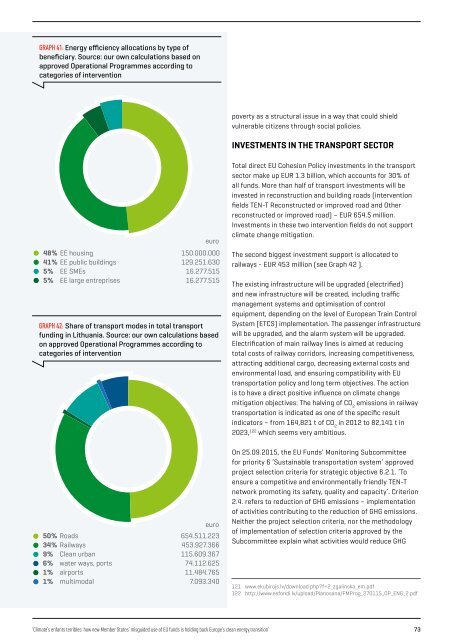ENFANTS TERRIBLES
enfants-terribles
enfants-terribles
You also want an ePaper? Increase the reach of your titles
YUMPU automatically turns print PDFs into web optimized ePapers that Google loves.
GRAPH 41: Energy efficiency allocations by type of<br />
beneficiary. Source: our own calculations based on<br />
approved Operational Programmes according to<br />
categories of intervention<br />
poverty as a structural issue in a way that could shield<br />
vulnerable citizens through social policies.<br />
INVESTMENTS IN THE TRANSPORT SECTOR<br />
euro<br />
48% EE housing 150.000.000<br />
41% EE public buildings 129.251.630<br />
5% EE SMEs 16.277.515<br />
5% EE large entreprises 16.277.515<br />
GRAPH 42: Share of transport modes in total transport<br />
funding in Lithuania. Source: our own calculations based<br />
on approved Operational Programmes according to<br />
categories of intervention<br />
euro<br />
50% Roads 654.511.223<br />
34% Railways 453.927.366<br />
9% Clean urban 115.609.367<br />
6% water ways, ports 74.112.625<br />
1% airports 11.484.765<br />
1% multimodal 7.093.340<br />
Total direct EU Cohesion Policy investments in the transport<br />
sector make up EUR 1.3 billion, which accounts for 30% of<br />
all funds. More than half of transport investments will be<br />
invested in reconstruction and building roads (intervention<br />
fields TEN-T Reconstructed or improved road and Other<br />
reconstructed or improved road) – EUR 654.5 million.<br />
Investments in these two intervention fields do not support<br />
climate change mitigation.<br />
The second biggest investment support is allocated to<br />
railways - EUR 453 million (see Graph 42 ).<br />
The existing infrastructure will be upgraded (electrified)<br />
and new infrastructure will be created, including traffic<br />
management systems and optimisation of control<br />
equipment, depending on the level of European Train Control<br />
System (ETCS) implementation. The passenger infrastructure<br />
will be upgraded, and the alarm system will be upgraded.<br />
Electrification of main railway lines is aimed at reducing<br />
total costs of railway corridors, increasing competitiveness,<br />
attracting additional cargo, decreasing external costs and<br />
environmental load, and ensuring compatibility with EU<br />
transportation policy and long term objectives. The action<br />
is to have a direct positive influence on climate change<br />
mitigation objectives: The halving of CO 2<br />
emissions in railway<br />
transportation is indicated as one of the specific result<br />
indicators – from 164,821 t of CO 2<br />
in 2012 to 82,141 t in<br />
2023, 122 which seems very ambitious.<br />
On 25.09.2015, the EU Funds’ Monitoring Subcommittee<br />
for priority 6 ‘Sustainable transportation system’ approved<br />
project selection criteria for strategic objective 6.2.1. ‘To<br />
ensure a competitive and environmentally friendly TEN-T<br />
network promoting its safety, quality and capacity’. Criterion<br />
2.4. refers to reduction of GHG emissions – implementation<br />
of activities contributing to the reduction of GHG emissions.<br />
Neither the project selection criteria, nor the methodology<br />
of implementation of selection criteria approved by the<br />
Subcommittee explain what activities would reduce GHG<br />
121<br />
122<br />
www.ekubirojs.lv/download.php?f=2_zgalinska_em.pdf<br />
http://www.esfondi.lv/upload/Planosana/FMProg_270115_OP_ENG_2.pdf<br />
‘Climate’s enfants terribles: how new Member States’ misguided use of EU funds is holding back Europe’s clean energy transition’ 73


